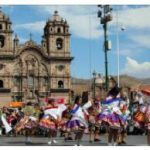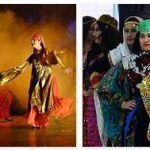
Peru Culture
Like Ecuador and Bolivia, Peru is one of the most »indigenous« countries in South America. Quechua, the language of the Inca, is the country’s second official language. On the territory of pre-Columbian Peru there were since 2500 BC. Chr. Settlements with houses. State organizations developed such as the Nazca culture, the Huari culture, the Tiahuanaco empire and, in the middle highlands, the Inca empire from around 1200 AD.
The high-ranking Inca civilization had a road network (Qhapaq Ñan) that was larger than that of the Romans. The fortress-like city complex of Machu Picchu in the Andes, built around 1450, is evidence of its architecture. Characteristic of her art are figures made of gold or silver, which mainly represent people and llamas. On the hunt for the legendary treasures of the golden land Pirú, the conquistador Francisco Pizarro conquered in 1532with a small army the Inca state weakened by internal turmoil. According to physicscat, Peru became the political and cultural center of the Spanish colonial empire on the South American subcontinent. This is still reflected today in the impressive colonial buildings of the conquerors, 600 of which have been preserved in the capital Lima alone. In them, European building forms merge with indigenous style elements to create an artful colonial baroque (Peruvian art, Latin American art).
The most important writer is M. Vargas Llosa , who was awarded the Nobel Prize for Literature in 2010. He is one of the most important representatives of the boom in Latin American literature that began in the 1960s, in which he played a major role with his novel “La ciudad y los perros” (1963; German “The city and the dogs”). Vargas Llosa’s works are often based on real events or autobiographical experiences and give a picture of Latin American society (Peruvian literature) through detailed observation.
The country’s music is influenced by the Inca heritage with its pan and queña flutes and ancient trumpets. It mixes with Hispanic influences and modern pop music to create a distinctive style. Puno on Lake Titicaca is a folklore capital. Many typical dances come from this region and are performed by dancers in colorful costumes. The colorful weaving products from the highlands are well known. The traditional clothes of the women are colored skirts, the Peruvian poncho is used to protect against rain and indigenous people in particular wear the typical hats made of wool.
The national sport is football, but equestrian sports and surfing are also very popular. Mountaineering in the Andes is mainly practiced by tourists.
World Heritage Sites in Peru
World Heritage Sites (K) and World Natural Heritage Sites (N)
- City of Cuzco (K; 1983)
- Ruins of the city-like Inca mountain fortress Machu Picchu (K / N; 1983)
- Ruined city of Chavin (K; 1985)
- Huascarán National Park (N; 1985)
- Ruined city of Chan Chan (K; 1986)
- Manú National Park (N; 1987)
- Historic city center of Lima with the San Francisco Monastery (K; 1988)
- Río Abiseo National Park (C / N; 1990)
- Lines and floor drawings (scratches) from Nasca and Pampas de Jumana (K; 1994)
- Historic city center of Arequipa (K; 2000)
- Holy City of Caral-Supe (K; 2009)
- Great Inca Road »Qhapaq Ñan« in the Andes (K; 2014)
Arequipa Old Town (World Heritage)
Arequipa is located in the south of Peru at an altitude of around 2400 m at the foot of the 5842 m high Misti volcano. The cityscape presents a mixture of European and indigenous building techniques. The most interesting complex besides Arequipa Cathedral is the spacious Santa Catalina Monastery from 1579, which has preserved its cultural and architectural heritage in a unique way.
Arequipa Old Town: Facts
| Official title: | Historic city center of Arequipa |
| Cultural monument: | Historical center; Mixture of European and native building techniques by colonial masters and Creole or Indian masons; Colonial buildings, partly made of white tuff: La Compañía monastery with beautiful cloister, church with richly designed baroque facade (1698); Santo Domingo Church (around 1664), Santa Catalina Monastery (founded 1580); among other things arcades, vaults, inner courtyards, baroque facades |
| Continent: | America |
| Country: | Peru |
| Location: | Arequipa |
| Appointment: | 2000 |
| Meaning: | Masterpiece of the creative fusion of European and local architecture; impressive example of colonial settlements |
Holy City of Caral-Supe (World Heritage)
Caral-Supe, 200 km north of Lima, is an outstanding monument of human cultural history. It shows that there was already a flourishing civilization in America 1000 years before the Egyptian civilization. It originated around 5,000 years ago and is considered the oldest urban settlement on the American continent. The ruins consist of six monumental pyramid-like complexes, temples and palaces. Settlement ended around 1200 BC. Chr.
Holy city of Caral-Supe: facts
| Official title: | Holy city of Caral-Supe |
| Cultural monument: | Archaeological site of an area of approx. 0.6 km² in a desert-like plateau above the fertile valley of the Supe River; one of the oldest known settlements in America with a proven age of over 4,500 years; monumental, ceremonial architecture made of stone and earthworks, in the center six pyramids (with gigantic monoliths on the Great Temple, the largest pyramid); urban structure (with upper and lower town) with accommodation, work houses, sophisticated irrigation systems, burial mounds, round buildings (such as amphitheaters from a later phase with finds of musical instruments) and public spaces; Finds of woolen knot cords, so-called »Quipus«, aids for documentation and transmission of numerical data; |
| Continent: | America |
| Country: | Peru |
| Location: | about 190 km north of Lima |
| Appointment: | 2009 |
| Meaning: | Unique testimony to an early American high culture, outstanding example of the development of civilization on the Peruvian coast; outstanding finds of early architecture and urban planning in the Andes; exceptional examples of early counting systems |



